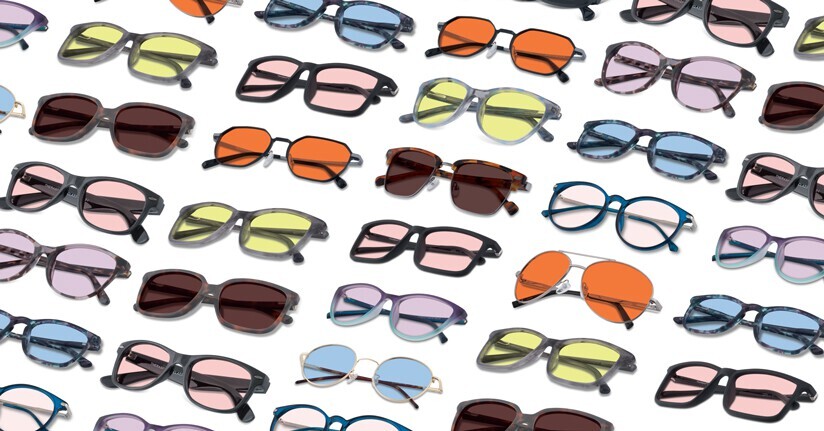4 Reasons Your Eyes Are Sensitive to Sunlight
Experiencing eye-related sensitivity to bright sunlight happens to the best of us; after all, who doesn’t feel the intense need to squint when spending even a few minutes outside without sunglasses? But for others, it can be a chronic problem or one that is felt more severely—and for which there may be a multitude of causes. We offer four likely reasons why your eyes may be sensitive to outdoor light.
1. You have a diagnosed light-sensitive condition
Many medical or emotional conditions can trigger or lead to light sensitivity. Some are short-term complications of an injury, while others may be lifelong conditions that require long term management. At their core, however, they represent impairment in the way the eyes and brain interpret bright light. This makes peak light from the sun a particularly potent complication. Here is just a sampling of conditions that are known to bring on sunlight sensitivity.
Migraine
For both children and adults who have migraine (or other headache disorders), sunlight is one of the biggest triggers and regularly worsens pain and other symptoms too. Among light-sensitive headache disorders, sun exposure can trigger attacks in as little as five minutes!1 Many migraineurs also believe they have seasonal variations in their attacks—which may be influenced by the totality of light exposure—and research shows that those who do are more susceptible to their eyes being sensitive to or triggered by sunlight.2-4
Even those without chronic migraine can experience sun-induced headaches on a regular basis that include migraine-like symptoms.
Concussion
As you might expect, an injury to the head or face can leave some serious repercussions—including photophobia and sunlight sensitivity, among other eye-related symptoms. Patients can experience this sensitivity in the immediate aftermath of the concussion, like John, a collegiate athlete:
"John lost consciousness during practice and reported it to the athletic trainer along with the symptom of the worst headaches of his life, the inability to wake up, and the pain from sunlight…"
(source: trace.tennessee.edu)
This is why experts have encouraged schools to seat students away from direct sunlight (e.g. near windows) when in class. But keep in mind: you do not want to avoid light altogether as that can also result in negative outcomes.5
Furthermore, persistent post-concussion symptoms can occur well after the injury, prolong the recovery process, and lead to ongoing risk for sensitivity to sunlight. Much like migraine, exposure to bright outdoor light can trigger the onset of other symptoms or simply make the ones you do have feel noticeably worse.
Dry Eye
With dry eye being one of the leading causes of general light sensitivity, it is no surprise that sunlight too has been shown to worsen ocular dryness and irritation as well as increase the risk for exposure to irritating debris. In fact, ongoing exposure to sunlight and high temperatures (e.g. through living in a tropical or warm climate area) may increase the odds for developing dry eye disease.6 And with the heavy presence of migraine and other co-occurring disorders among those with dry eye, the risk for sunlight-sensitive reactions may be further compounded.
Lupus
There is a distinct difference between skin photosensitivity and eye-related photophobia in those who have the chronic autoimmune disease known as lupus. However, both issues can be brought on by exposure to intense sunshine. Ocular light sensitivity can not only lead to pain via sunlight, but it also can lead to other physical changes like: skin or muscle changes around the eye, lesions, visual floaters, dry eyes, inflammation, and retinal dysfunction. And ALL of these can cause further discomfort when in the presence of outside lighting.
Anxiety, Depression and/or Panic
If you suffer from intense emotional distress, particularly with a diagnosed anxiety or panic disorder, then you may notice that bright sunlight is an antagonist in your life. Separate studies have shown that these conditions are generally more sensitive to environmental lighting.7,8 And this doesn’t even begin to address the cumulative effect that chronic illnesses like migraine and stress/depression have on photophobic behaviors. All of this usually leads to individuals retreating inside to a dark room or other light-avoiding outcomes. Of course, natural daylight might help improve some of the emotional turmoil in patients, and at minimum it is shown to have positive effects on professional satisfaction and workplace stress and anxiety—so it can be a catch-22 as to how much sunlight a person should enjoy.
2. Lack of eye protection
A lack of proper eye protection during both normal and extreme exposure to sunlight can lead to disorders of the eye and ultimately hasten the development of light-sensitive discomfort. Photokeratitis is typically described as a “sunburn” on the eye (ouch!), which indicates excessive subjection to ultraviolet light particularly from the sun. Even reflections of sunlight off certain surfaces (e.g. water or snow) can cause similar damage and result in eye sensitivity to sunlight, ocular pain, blurry vision and more.
Not wearing protective sunglasses or other eyewear can lead to conditions like certain cancers, eye growths (e.g. pterygium or pinguecula), cataracts, and age-related macular degeneration.9 And while there is no definitive connection, we know that any lasting dysfunction within the eye can make photophobia all the more likely to manifest.
So what makes for highly-effective and protective sunglasses? There are several specific qualities to look for, like:
- 100% UVA/UVB blocking
- Polarized lenses to cut down on harsh outdoor glare
- Large lenses and/or wraparound frames for enhanced protection
- Thicker, non-transparent frames to keep surrounding light from sneaking in
- Snow goggles for specific use when skiing or in the snow
Wearing hats, using an umbrella, and (of course) avoiding the practice of “sun gazing” are additional steps you can take to reduce the sunlight’s stress on your eyes as well.

3. Long-term avoidance of light
Ever wonder what constant darkness does to the eyes? Well, cocooning oneself in darkened environments (whether intentional or not) can ultimately make you more light sensitive to outdoor sunlight. For example, in places where longer periods of daylight and/or darkness are observed (notably in subarctic regions), people with migraine were more likely to experience attacks that fluctuate with the seasons AND had a greater risk for being triggered by sunlight.10 This is almost certainly influenced by the extreme changes in lighting conditions throughout the year.
The way the eyes adapt to these variations in light—both on a small or large scale—is central to the ensuing photophobia. After all, most of us have had the ‘wow it’s way too bright’ reaction when stepping outside of the movie theater. Now imagine having that feeling every day as a chronically sensitive person, and it’s easy to see why they might turn away from the daylight as much as possible. The problem becomes that these behaviors ultimately exacerbate the kind of heightened sensitivity to rapid light changes that many describe. And even those without an existing disorder experience this kind of dark adaptation of the eye.11
4. The physical characteristics of your eyes
Believe it or not, the basic physical makeup of your eyes can affect your sensitivity to exterior sunlight. For example, having light-colored eyes has been linked to photophobia because they are structurally unable to block the effects of bright lighting due to less pigmentation. As a result, patients may admit to feeling more eye-related discomfort out in the sun.
Similarly, less-than-optimal concentrations of macular pigment hinders the absorption of harmful blue light—which would otherwise help protect photoreceptor cells in the eye and buffer against photophobia. Through this simple biological anomaly, the allowance of more blue wavelengths that penetrate the retina can significantly increase a person’s sensitivity to and discomfort in sunlight.
Additional Reading:
Why Does the Sun Give Me a Headache?
Photophobia, Light Sensitivity: Facts and Statistics
The Ultimate Guide to Photophobia
References:
1Vijayan N, Gould S, Watson C. Exposure to sun and precipitation of migraine. Headache. 1980 Jan;20(1):42-3.
2Francis MV. Brief migraine episodes in children and adolescents-a modification to International Headache Society pediatric migraine (without aura) diagnostic criteria. Springerplus. 2013 Dec;2(1):77. doi: 10.1186/2193-1801-2-77. Epub 2013 Mar 4.
3Haque B, Rahman KM, Hoque A, Hasan AT, Chowdhury RN, Khan SU, Alam MB, Habib M, Mohammad QD. Precipitating and relieving factors of migraine versus tension type headache. BMC Neurol. 2012 Aug 25;12:82. doi: 10.1186/1471-2377-12-82.
4Bekkelund SI, Hindberg K, Bashari H, Godtliebsen F, Alstadhaug KB. Sun-induced migraine attacks in an Arctic population. Cephalalgia. 2011 Jul;31(9):992-8. doi: 10.1177/0333102411409071. Epub 2011 May 31.
5Rose SC, McNally KA, Heyer GL. Returning the student to school after concussion: what do clinicians need to know? Concussion. 2015 Aug 6;1(1):CNC4. doi: 10.2217/cnc.15.4. eCollection 2016 Mar.
6Sahai A, Malik P. Dry eye: prevalence and attributable risk factors in a hospital-based population. Indian J Ophthalmol. 2005 Jun;53(2):87-91.
7Bossini L, Martinucci M, Paolini K, Castrogiovanni P. Panic-agoraphobic spectrum and light sensitivity in a general population sample in Italy. Can J Psychiatry. 2005 Jan;50(1):39-45.
8Gerbaldo H, Cassady S, Maurer K, Pieschl D. The assessment of light intensity preference in psychiatric patients: a questionnaire. Acta Psychiatr Scand. 1997 Mar;95(3):236-41.
9Izadi M, Jonaidi-Jafari N, Pourazizi M, Alemzadeh-Ansari MH, Hoseinpourfard MJ. Photokeratitis induced by ultraviolet radiation in travelers: A major health problem. J Postgrad Med. 2018 Jan-Mar;64(1):40-46. doi: 10.4103/jpgm.JPGM_52_17.
10Bekkelund SI, Müller KI, Wilhelmsen A, Alstadhaug KB. Photophobia and Seasonal Variation of Migraine in a Subarctic Population. Headache. 2017 Sep;57(8):1206-1216. doi: 10.1111/head.13131. Epub 2017 Jun 19.
11Rufiange M, Beaulieu C, Lachapelle P, Dumont M. Circadian light sensitivity and rate of retinal dark adaptation in indoor and outdoor workers. J Biol Rhythms. 2007 Oct;22(5):454-7.

TheraSpecs® Glasses for Light Sensitivity
Find the glasses that fit your needs and lifestyle, and stay protected from screens, fluorescents, unwanted blue light, sunlight, flashing lights, and more.
Shop Now



